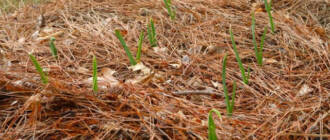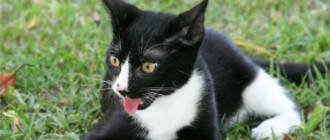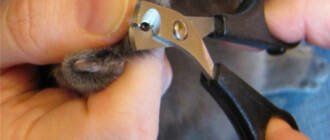Sturdy Toothies Gel is indicated for inflammation and teething

- A cat's teeth change: what the cat owner needs to know
- At what age do baby teeth appear?
- How to take care of your pet during the change of teeth
- Features of nutrition
- How to behave with your cat
- Features of care
- When kittens' teeth change, depending on the breed
- Symptoms of Changing Teeth
- Gum problems
- Kitten behavior
- How Kittens' Teeth Change
- Changes in the well-being and behavior of kittens
- Kitten at eight weeks of age
- Possible complications of changing teeth
- How to help a kitten with a tooth change
- How a cat's teeth grow later in life
- Change to molars
- Lifetime
- Loss of teeth in older individuals
- The formation of a cat's dentition from birth
- Order of teething:
- Change of milk teeth to permanent teeth
- The permanent dentition consists of:
- Complications in which to go to the veterinarian
- Gingivitis or Bleeding Gums
- Residual teeth
- Kitten Care During a Kitten's Changing Teeth
- Possible complications during the period of tooth replacement
A cat's teeth change: what the cat owner needs to know
Despite the fact that the cat is fluffy, playful and affectionate, it is a predator with a well-developed jaw. A cat's teeth are a tool for hunting and capturing prey. The welfare of the animal depends on their health. Childhood changes of teeth, tooth decay, tartar and malocclusion can cause a lot of problems. They can be avoided by paying attention to the relevant signs in time.
By the age of eight months, the pet's jaw is fully formed. An adult, no matter what sex, has 30 teeth.
In essence, a cat's teeth are a tool that dissects food. This is due to the fact that the cat is a predatory animal, and its main food is rodents and small animals. It is this fact that determines that a cat's teeth are very sharp; they can easily "cut" meat.
- The pulp, a centered hollow cavity filled with capillaries containing nerve endings. This part is designed to nourish the bone tissues.
- Dentine – is a highly mineralized substance that fills the maximum of the space from the pulp to the outer shell. Dentin is essentially the base of the tooth. It is a hard material, but very sensitive. Prone to rapid deterioration if the upper protective layer is damaged.
- Enamel is a white shell that covers the outside of the tooth. It is not connected to the nerves, so it is not sensitive. Enamel is a full-fledged protection from the negative effects of factors of various kinds. If this layer is abraded, eating causes pain.
The age of the cat is easy to recognize by the condition of the teeth. Upon reaching the age of 5-6 years, the animal has severely worn incisors, yellowing or even browning of the enamel. When the animal reaches 10-12 years of age, it is more likely to be without fangs.
At what age do baby teeth appear?
A newborn baby has no teeth. This fact is influenced by eating behavior. The kitten eats only mother's milk. If babies were born with teeth, this could traumatize the cat's nipples.
How to take care of your pet during the change of teeth
It's important to understand that a kitten's tooth change is not an illness. No special privileges are needed for him. Usually this process is painless, except for abnormalities. In this case, it is necessary to contact the veterinarian and follow his recommendations.
Features of nutrition
Feeding the baby should correspond to its age, regardless of the process of changing teeth. It is worth remembering that the normal growth of teeth is provided by phosphorus and calcium. Vitamins A and D are needed to absorb these micronutrients. If the food is not rich in these substances, specialized supplements are needed. Other vitamins will also not be superfluous, since during the period of change of teeth, the kitten's immunity weakens. The baby should definitely be given:
If a ready-made food is chosen for feeding, it is worth paying attention to products specially designed for kittens. Quality food contains all the vitamins and trace elements necessary for the development of kittens, as well as balanced with the needs of the growing body.
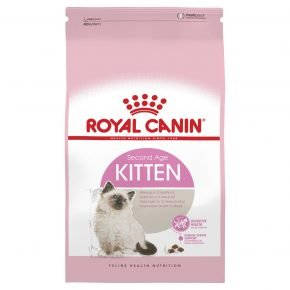
Royal Canin Kitten is suitable for kittens up to 12 months of age
How to behave with your cat
Even though he may be under a little stress from itchy gums, you shouldn't let him chew on anything. Especially you should not let him play with his hands, otherwise the kitten may get used to it and it will turn into a problem at an older age. It is desirable to buy several diversified toys, which involve both joint play with the baby, as well as independent.
At any age, a cat needs affection. You can't ignore your baby, you can't wave him off.
Features of care
The time when teeth begin to change is accompanied by inflammation of the gums. To alleviate the condition, you can use a gel that has an anti-inflammatory and analgesic effect.
When kittens' teeth change, depending on the breed
This process is generally the same for all breeds, its intensity mainly depends on the individual characteristics of the body: the animal can endure everything easily and not feel discomfort, or, on the contrary, itching will appear, as a result of which the pet will begin to chew on furniture and other hard objects.
- Incisors. They erupt first in 2-3 weeks of life, located in front between the canines on the upper and lower jaws. They are necessary for gently grasping prey and small food and its further biting. Cats also use their incisors for hair grooming. Milk incisors fall out at 2-4 months.
- Fangs. They erupt at 3-4 weeks of age. They help to grip or bite prey firmly and also serve as protection during conflicts with other animals. At what age do kittens' canines change? Permanent canines appear around the fourth month of life.
- Premolars. Grow out at four to six weeks of age. Help carry prey and grind food. Root premolars may change within a couple of months, usually from the fourth through sixth months.
- Molars. Are only molars, growing in the fifth month, located on the upper and lower jaws at the very end of the dentition. They allow you to grind larger pieces of food more thoroughly.
Symptoms of Changing Teeth
Gum problems
When complications arise, the kitten may experience pain, loss of appetite and lethargy. The gum becomes inflamed and takes on a bright red hue. All of the above symptoms are quite acceptable as long as they do not last more than a day. If the condition does not improve after this time, the animal should immediately be seen by a veterinarian.
Kitten behavior
During teething, the following changes in kitten behavior may be observed:
Sometimes kittens rub their faces with their paws or begin chewing on furniture and other hard objects.
How Kittens' Teeth Change
The beginnings of permanent teeth form deep within the gums long before they erupt. As they grow, they come into contact with the milk roots, and these gradually thin out and dissolve. At the same time, the tops are loosening.
Owners seldom notice when teeth fall out; kittens often swallow them along with food. But if your kitten is 4-8 months old and a baby tooth or fang suddenly fell out, don't be alarmed, it's normal.
Native (permanent) teeth grow in the same order as temporary teeth:
- At 3 to 4 months, the baby teeth fall out and the permanent incisors erupt;
- At 4 to 5 months, the lower and then the upper canines emerge;
- At the same time, the infant premolars are loosened, and the molars are shaped by six months of age;
- By 7 months of age, the formation of 4 molars is completed, they grow singly at the edges of each row.
The complete set consists of 30 pieces: 16 on the top, 14 on the bottom. The dental formula of a single upper gum sector includes 3 incisors, a canine, 3 premolars, and a molar. The mandible differs only in the number of premolars: 2 on each side instead of 3.
Changes in the well-being and behavior of kittens
The sprouting of teeth is painless, but accompanied by strong itching. The cat scratches its gums, gnawing on inedible objects, biting its owner's fingers, rubbing its paw on the edges of furniture.
At the same time, they notice the following natural changes:
- A repulsive smell from the mouth appears, because inflammation cannot be avoided. It passes a month after the end of growth.
- Salivation increases when playing, feeding, it is a protective reaction against mucous membrane inflammation in the mouth.
- The place where the next tooth appears is swollen, it recovers 1 to 2 days after eruption.
- The animal eats worse, but does not lose its appetite completely.
- Sometimes the temperature rises to 39.5 ℃, the kitten looks for a warm place, lays down under a blanket.
- Bleeding after shedding does not exceed 3 minutes.
Baby teeth and molars emerge from different holes, so it is not uncommon for a new one to erupt when the temporary one has not yet fallen out. This phenomenon does not require intervention if they are not touching each other, the gum shows no signs of inflammation, and the deadline for replacing the teeth has not yet passed.
Kitten at eight weeks of age
When kittens reach the age of two months, they usually stop receiving their mother's milk and switch to feeding themselves. You can switch kittens to a high-calorie food that will provide them with all the nutrients they need and fit the size and texture of the croquette. This should be done gradually so as not to disrupt their digestion. It is also a good idea to discuss vaccinating kittens with your veterinarian at this time.
At this age, kittens grow very quickly. Even though their energy needs have decreased, kittens need three times as much energy as an adult cat. Kittens need to prepare for their most intensive weight-gaining period which takes place at four to five months of age, when kittens will be putting on 100 grams per week. Kittens' sleep regime becomes close to that of an adult cat (from 13 to 16 hours a day). The socialization processes are completed. Now they can play with other kittens and with you.
At the age of 12-15 months, the kitten becomes an adult cat. His growth stops. Knowing your kitten's early life and needs allows you to create the necessary conditions for your pet to reach adulthood healthy.
Possible complications of changing teeth
The process of changing from baby teeth to permanent teeth is considered physiological. Therefore, minor ailments caused by sore gums or a short-term increase in body temperature are considered a variant of the norm. The main thing – carefully monitor the condition of the kitten in the dynamics and do not ignore the warning signs, which may indicate the development of pathology.
The list of possible complications includes:
- Severe inflammation of the gums. When a kitten eats food or chews foreign objects, pathogenic flora enters the oral cavity – the main source of irritation, redness and tissue swelling. Normally, the body copes with it on its own. But if local immunity is reduced, the balance of safe and pathogenic flora is disturbed, and the inflammatory process becomes more pronounced.
What to do. To eliminate severe swelling, soreness and festering of the gums, use special antiseptic ointments and solutions. A veterinarian can help select the drug and treatment regimen.
- Complete refusal of food. Increasing discomfort when chewing food affects appetite and leads to forced starvation. The kitten begins to walk up to the bowl, sniff the food, and anxiously step aside. If the behavior persists for more than a day, the situation can become critical.
What to do.To regain interest in food, include canned food and meat jellies for cats in the diet. Wet food does not traumatize the gums and attracts animals with its rich flavor.
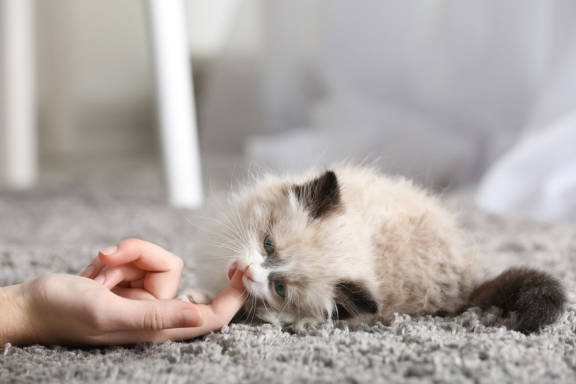
- Delayed tooth change. The growth of permanent teeth should provoke the loss of milk teeth. However, if the teeth change with a delay, the molar will erupt next to it, while the milk one will remain in its cavity and not even wobble. The result can be disturbed bite, jaw clamping damage, bits of food stuck between the teeth, and plaque buildup.
What to do. If the milk tooth does not interfere with growth permanently and does not provoke inflammation of the gum, experts recommend waiting until the kitten is 8 months old. As a rule, by that time the tooth will fall out on its own. However, if the double row of teeth traumatizes the gum and causes discomfort while chewing, the kitten should be shown to the veterinarian and have the milk tooth forcibly removed.
How to help a kitten with a tooth change
- Buy new rubber toys and cat teethers. Teething toys can help relieve itching and sore gums. The main thing is not to pull the toy toward you while playing, but to allow the cat to grab it with its whole mouth and chew exactly as much as it wants. To increase the effect, keep the toy in the fridge. The cool surface works well against swelling and inflammation.
- Hide the wiresUnder voltage. Hide wires behind baseboards or obstruct them with furniture. If a kitten chews through the insulation, it can cause serious electrical injury, up to and including death.
- Keep an eye on your kitten's oral hygiene. Inspect the mouth regularly for non-healing sores, abscesses, plaque, or delayed tooth changes. If your gums remain swollen for more than 2 weeks or you think a new tooth is growing at an angle and scratching your gums when your jaws close, see your veterinarian right away.
Note. Brushing with a veterinary toothpaste should only be done as directed by a professional. Brushing with a toothbrush or a finger brush can cause additional trauma during the period of tooth changes.

- Adjust the diet. Soak dry kitten food in water or use canned cat food and spiders.
Note. Giving up dry food completely is not recommended. Compressed pellets are necessary for kittens to develop the jaw apparatus. - Reschedule mandatory vaccinations. The change of baby teeth to permanent teeth is not a direct contraindication to vaccination. But it can weaken the immune system and aggravate the pet's condition during the quarantine period.
- Supplement his diet with vitamin and mineral supplements. Consult your veterinarian. During an active replacement of milk teeth with molars, kittens may be prescribed supplements with double the dose of calcium and phosphorus and vitamins A and D.
- Spend more time with your kitten. Help your pet get through the stress by distracting him with play or petting. The main thing is not to let the baby bite your hands. Otherwise, this can become a habit and cause serious discomfort in the future.
How a cat's teeth grow later in life
By the number of teeth in kittens you can determine their approximate age. A full "fighting set" of 30 appears at 7-12 months of age.
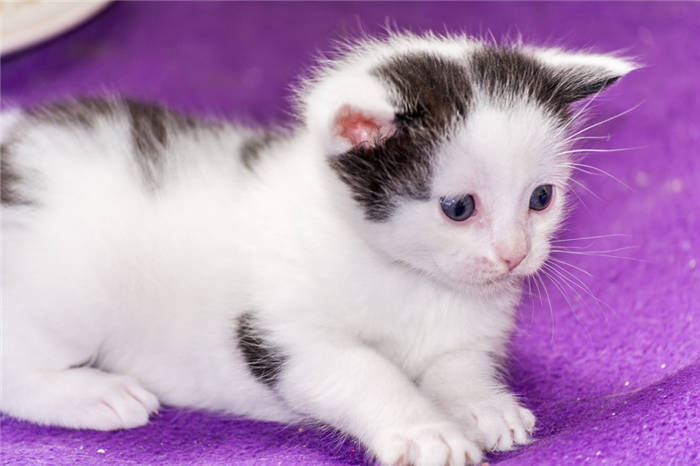
Change to molars
Change to molars follows the same pattern as the eruption of milk teeth, that is, from the center of the jaw to its edge. It looks as follows:
The molars, like the incisors and canines, are arranged in pairs: 2 on the lower jaw and 2 on the upper jaw. The symptomatology during this period is exactly the same, but with one difference. Unpleasant odor from the mouth during the change to the molars is the norm, but only if it disappears quickly. If it persists for more than 2 weeks, the pet should be shown to the doctor.
Unlike the milk row, the molar stays for life. To avoid its premature loss, oral hygiene should be observed.
Lifetime
Regular brushing and a proper diet rich in calcium and phosphorus can extend the life of molars into old age. Premature loss and loosening is not normal and can be a sign of the following conditions:
Prolonged use of antibiotics and hormones also increases the risk of premature loss. The possibility of withdrawal is determined by the veterinarian, as in some cases the loss of teeth is far from a bad outcome.
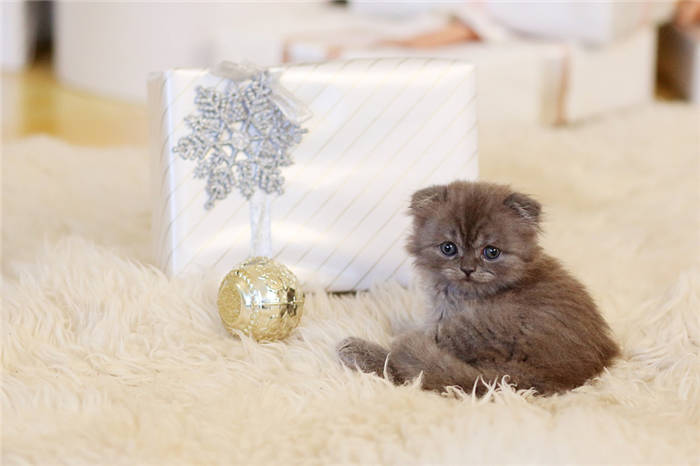
Loss of teeth in older individuals
The first significant changes appear at 1.5 years of age. The teeth become denser and plaquey, and the enamel becomes noticeably yellow. After six months, abrasions and tartar form on the lower incisors, and at 5 years of age the cat's chewing surface begins to deteriorate.
About 70% of older individuals lose their teeth at 10-14 years of age. At this age, their incisors fall out, and at age 14-15, their canines fall out. This is due to the presence of only one root, which is not able to stay in the hole for so long.
The formation of a cat's dentition from birth
A complete set of baby teeth in cats consists of 26 pieces. The onset of gum eruption is noted between 2-3 weeks from birth (usually closer to the 3rd week). A full milk bite is formed by 6 weeks (maximum by 8 weeks). The appearance of the first sharp teeth is a signal that kittens can begin the introduction of "chewing" food.
Order of teething:

Change of milk teeth to permanent teeth
When do kittens/cats change their milk teeth?
Changing teeth in cats is a painless process and usually goes unnoticed by owners. The beginning is noted by the age of 3-5 months. By 7-8 months of age, a permanent root bite is usually formed, including 30 pieces of teeth.
The permanent dentition consists of:
The order in which the teeth change
There is no clear order or exact timing of tooth changes, but most experts are of the opinion that in cats everything changes in the same order as it grows:
Characteristics of a healthy grin
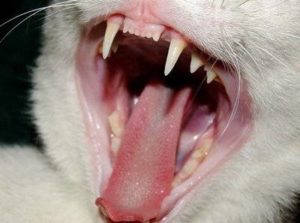
Healthy molars are clear white at first, with a slight tinge of yellowing over time. After 4-5 years of age, you may see signs of tooth surface wear due to age – the canines are slightly blunted, and the curvature of the premolars and molars is smoothed out. Cats/cats over the age of 5-6 years may already be missing some permanent teeth, but healthy animals do just fine without them.
How often do teeth change in cats/cats?
The teeth of domestic whiskered carnivores change once in a lifetime, replacing the milk components with permanent ones. If tooth loss has been noted at any age over 1 year, it is not the norm and there must be a definite reason for it.
Complications in which to go to the veterinarian
Inspect your pet's mouth every few days to avoid complications. If he is showing lethargy, restlessness, constant meowing and refusing to eat for more than a day, make an appointment to be seen at the vet. These symptoms often occur with severe inflammation.
Gingivitis or Bleeding Gums
Gingivitis, or inflammation of the gums, is the most common complication. When this problem occurs, the mucous membranes become bright red and severely swollen. The fur on the chest becomes ruffled due to excess saliva dripping from the mouth.
If severe bleeding gums, harsh, disgusting odors or odors are added to these symptoms, it may be periodontal disease, affecting the deeper layers of the mouth. Don't delay in going to the vet, as self-treatment won't help.

Residual teeth
This phenomenon is called persistence. Preservation of two rows is fraught with a violation of the bite and increased mucosal trauma. The problem is solved surgically. The mustached patient is put under anesthesia and all unnecessary things are removed. Despite general anesthesia, cats easily tolerate such an operation.
For an easier process, help your whiskered pet with mouth brushing, incorporate solid foods into his diet or stick to soft foods. Talk to your vet about adding vitamin and mineral supplements and have them checked regularly at the vet's office before a full canine change. If you have any problems with chewing or loss of interest in your favorite treats, check outside of the scheduled schedule.
This article is for informational purposes only. Contact your veterinarian!
Kitten Care During a Kitten's Changing Teeth
The change of milk teeth in cats should take place under the supervision of not only the owner. It is advisable to show your pet to a veterinarian to confirm the correct origin of the process. This is necessary even if, at first glance, nothing indicates that there is a problem.
Due to the fact that the most frequently diagnosed problem of the oral cavity and teeth in cats in particular is tartar, regular brushing of the teeth is necessary. In the wild, such a problem does not exist in members of the feline family. Domestic animals get softer types of food, provoking the formation of plaque.
Under the influence of opportunistic microflora in the oral cavity, as well as exposure to salts and food debris, tartar is formed. Advanced cases of tartar formation in cats require cleaning in veterinary clinics under general anesthesia.
You can prevent the formation of calculus by feeding your cat special food (do not give him too soft food), giving him dry food with coarse particles, and cleaning the cat's teeth by yourself several times a month with special pads. Measures to prevent dental problems in cats include sanitation of the mouth with the medication Stomadex.
Vaccination during the period of tooth replacement is a controversial issue. Some experts do not recommend vaccinating an animal during a change of milk teeth, while others, on the contrary, do not consider the physiological process a contraindication to vaccination. There are no obvious contraindications to vaccinating kittens during the loss of milk teeth.
The contraindication is the presence of other abnormalities in the kitten's body. It is not recommended to immunize babies with weak immunity and in the presence of colds. After a clinical examination prior to routine vaccination, the veterinarian should determine whether the vaccination can be done.
Possible complications during the period of tooth replacement
Despite the fact that the physiological process of changing milk teeth into permanent ones is rarely accompanied by complications, veterinary specialists strongly recommend routine examinations for timely detection of possible anomalies and pathologies.
The most common complications during the period of change of teeth in cats are:
- Inflammation of the gums. The eruption of teeth or their change is accompanied by minor processes of inflammatory nature, which stop on their own after the formation of the row. Feeding the wrong food or natural food prolongs the inflammation of the gums.
- Stuck baby teeth. Often enough, the baby teeth do not start to wobble and fall out until the baby teeth have erupted. When the physiological process is disturbed, the milk bone stays in the gum, thus preventing normal passage. Untimely help leads to injuries to the gums, cheeks and even lips of the animal.
There are also different causes that provoke disorders in the change of teeth. Among them are distinguished:
- Incorrect location of the rudiment of the permanent tooth;
- Increased growth of the lower or upper jaw during the period of tooth change;
- Too narrow lower jaw (in Persian breeds);
- Insufficient development of the masseter muscles;
- Genetic predisposition.
Attentive attention to your pet, makes it possible to promptly identify possible malfunctions in the formation of the pet's bite, the presence or absence of teeth. Change of teeth in cats should from time to time be monitored by a veterinarian.
If pathology begins, the doctor will be able to provide timely qualified assistance and complications can be avoided. It is important to remember that dental disease in cats in adulthood often begins with the process of changing their teeth.


